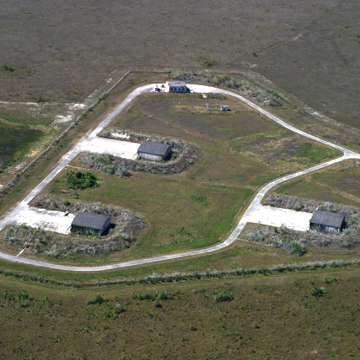Because of its strategic location at the threshold between the Atlantic Ocean and the Gulf of Mexico, South Florida has a rich heritage of military sites. The most recent additions to this portfolio were a series of missile bases constructed around Miami in the immediate aftermath of the 1962 Cuban Missile Crisis. Designed to protect the mainland United States against attack from the south, these military sites were located in remote locations at the periphery of the area’s growing urban centers.
The HM 69 Nike Hercules Missile Site, or Alpha Battery, was completed in 1964 and remained in operation until 1979. Located in Everglades National Park, it was one of the four South Florida sites that comprised the 2nd Missile Battalion of the 52nd Air Defense Artillery (2/52 ADA); the others were Bravo Battery in Key Largo, Charlie Battery in Miramar, and Delta Battery off Tamiami Trail (in what is now the Krome Service Processing Center). The Nike Hercules was a second-generation missile system designed to intercept jet aircraft, and was deployed throughout the United States and Western Europe. The four missile sites ringing Miami were integrated with shorter range HAWK missiles, were modified to intercept tactical ballistic missiles, and had the capability to use their ordnance against ground targets as well.
The HM 69 base was built on parkland already owned by the federal government. The site was located on a farm operated by the Iori family. Because the farm remained privately owned while the land around it was maintained by the National Park Service, the land was referred to as the “Hole in the Donut,” and it retained this appellation long after the property was transferred to the Department of Agriculture, and later to the Department of Defense. The site’s remote location in a preserved wildlife habitat created problems for the base’s personnel, who battled rats, alligators, and mosquitoes. The gravest danger to the post, however, came from wildfires ignited by equipment and fueled by dry grasses.
Aesthetically, the Nike Missile bases are spare and unassuming. Their design was driven by such pragmatic concerns as speed of construction (due to the perceived threat of Soviet and Cuban attack, and the need to replace the unhealthy temporary facilities erected in 1962), durability, and security. HM 69 is typical of bases built around the country in that it comprises two main components: a control center and a storage and launch center, which were separated in order to protect the inhabitants of the former from an accidental explosion at the latter. The structures employ a simple palette of concrete, concrete block, dimensional lumber, and corrugated steel sheeting. Only the radar and antennae installations (no longer extant) were taller than one story, so the base was nearly invisible when seen across the Everglades landscape. Over twenty buildings remain at the site, including three missile barns and a missile assembly building, as well as the firing control building, staff barracks, and other support structures. All told, 146 personnel lived and worked at the base.
In one respect, however, HM 69 is atypical of Nike missile bases. The facility was built without underground magazines due to the high water table in the Everglades. Whereas Nike sites elsewhere in North America employed subterranean bunkers to house their missiles, the sites in South Florida used three “barns” whose floors, like the roads and launch pads, were built atop soft earth that had to be stabilized to support the heavy missiles.
While no missiles were ever fired from the South Florida bases, the facilities played a key role in the Cold War. The Pentagon considered the 2/52 ADA to be the only air defense missile sites in the contiguous United States that deployed “under duress.” As a result, the troops of HM 69 were the only Hercules crews to be awarded the Army's Meritorious Unit Commendation for a Cold War deterrence mission.
HM 69 continued to operate until 1979, five years after all other Nike installations in the contiguous United States had closed. After the base was decommissioned, it was transferred to the National Park Service, which maintains the site and offers tours. HM 69 was added to the National Register of Historic Places in 2004.
References
Hach, Steve, and Jennifer W. Dickey. Cold War in South Florida: Historic Resource Study. Atlanta: U.S. Dept. of the Interior, National Park Service, Southeast Regional Office, Cultural Resources Division, 2004.





